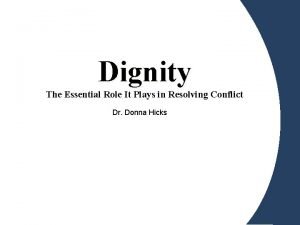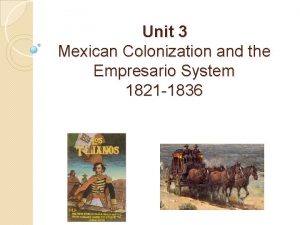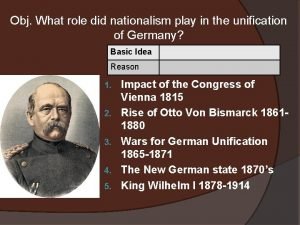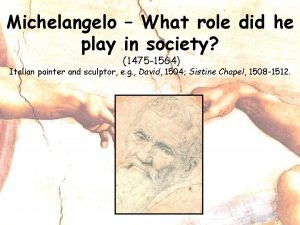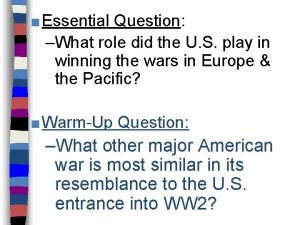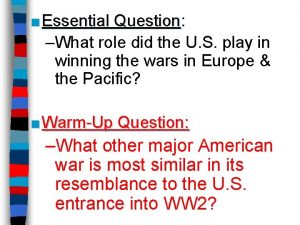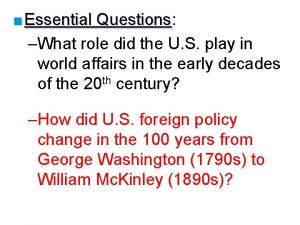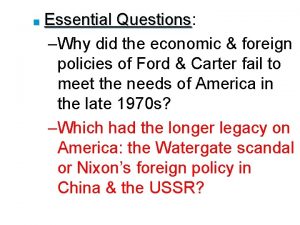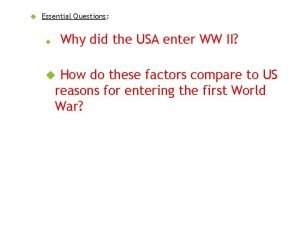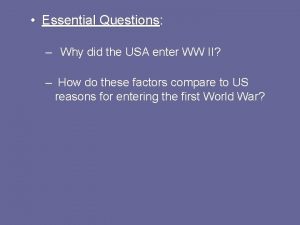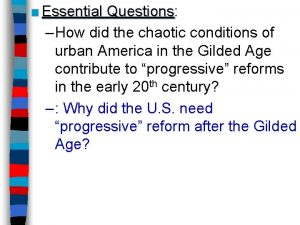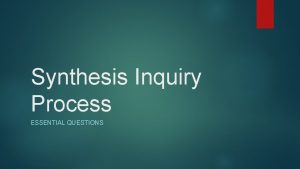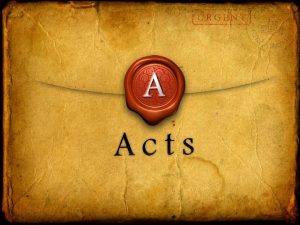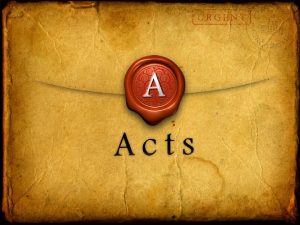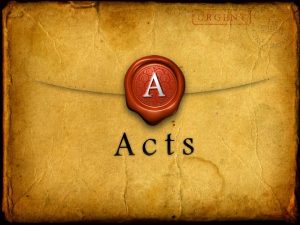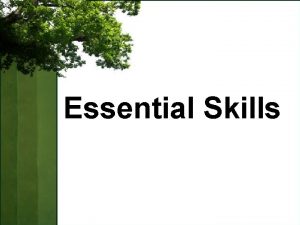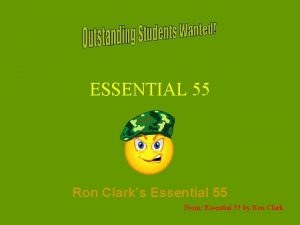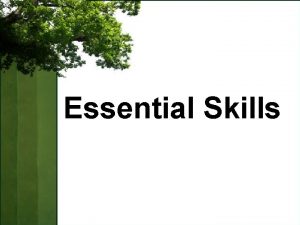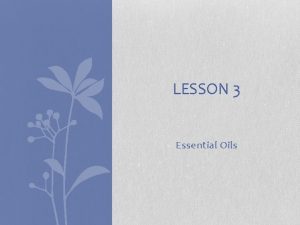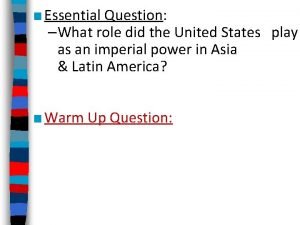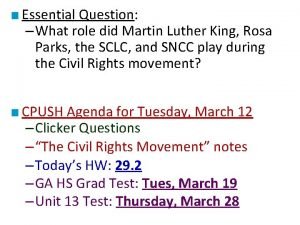Essential Questions Questions What role did the U






















- Slides: 22

■ Essential Questions: Questions –What role did the U. S. play in world affairs in the early decades of the 20 th century? –How did U. S. foreign policy change in the 100 years from George Washington (1790 s) to William Mc. Kinley (1890 s)?

The U. S. Becomes a World Power ■ At the turn of the 20 th century, the U. S. emerged as a world power: –The U. S. asserted its dominance in Spanish-American War (1898) –America built the 3 rd largest navy in the world –Annexed Hawaii, the Philippines, Puerto Rico, many Pacific islands –Asserted economic control over almost all of Latin America

The U. S. Becomes a World Power “Big Stick Diplomacy” “Moral Diplomacy” “Dollar Diplomacy” The U. S. developed a new, aggressive foreign policy under T. Roosevelt, Taft, & Wilson: ■ Their policies differed, but all revealed a desire to increase American wealth, military power, & stature in the world, especially Latin America ■

American Foreign Acquisitions, 1917

Theodore Roosevelt’s “Big Stick Diplomacy”

TR’s “Big Stick Diplomacy” ■ Roosevelt expand TR & Sechoped of Stateto. Elihu Root upon applied “bignew, stick”world diplomacy mostafter America’s stature effectively in Latin America the Spanish-American War: “Speak softly & carry a big stick, –TR believed in the superiority of you will go far” American Protestant culture & —TR’s favorite African proverb hoped to spread these values –To increase American economic & political stature in the world, the U. S. needed to be militarily strong & ready to fight if needed

TR’s “Big Stick Diplomacy” The U. S. paid $10 million for the canal ■ TR’s top foreign policy objective & leased it for $250, 000 per year was to build the Panama Canal & he used his “big stick” to get it: –When the Colombians rejected an offer to lease land in Panama to build a canal, TR supported a revolt for Panama independence A Panama Canal would facilitate world trade – In 1903, Panama (with the U. S. & allow the U. S. to quickly merge its Atlantic navy)naval became & signed & Pacific fleets ainnation an emergency a lease agreement for a canal

The Panama Canal was an engineering marvel, but one of the most important reasons for its completion was the scientific elimination of malaria-causing mosquitoes “The inevitable effect of our building the When in to 1914, the canal gave the Canalopened must be require us to police the USA a huge economic advantage in surrounding premises” the Western—Sec Hemisphere of State, Elihu Root

The Roosevelt Corollary warned European nations to stay out ■TR One of the greatest concerns was AND warned Latin American nations to be the intervention of European more responsible or the U. S. would nations in Latin America: intervene –In 1903, Germany & England threatened to invade Venezuela to recoup unpaid debts –TR issued Roosevelt Corollary to the Monroe Doctrine in 1904 claiming special “police powers” in the Western Hemisphere

The Roosevelt Corollary to the Monroe Doctrine, 1904 Additionally, the Lodge Corollary in 1912 refused to allow foreign companies to buy ports or establish military sites in Latin America

The Roosevelt Corollary used to justify Attempts to maintain orderwas in Latin American armed intervention the relied Dominican led to pro-American regimesinthat on dictatorial rule over its citizens Republic, Cuba, Haiti, Nicaragua, & Mexico


Big Stick Diplomacy ■ Foreign policy under TR extended to Asia as well as Latin America: –TR negotiated an end to the Russo-Japanese War in 1905 from Portsmouth, NH –Gentlemen’s Agreement in 1907 limited Japanese immigration –The Root-Takahira Agreement in 1908 protected America’s Open Door Policy in China

“Constable of the World”

William Howard Taft’s “Dollar Diplomacy”

Taft and Dollar Diplomacy ■ President Taft took over after TR & continued an aggressive foreign policy, called “Dollar Diplomacy” Diplomacy –Use U. S. wealth rather than military strength in foreign policy –In Latin America, U. S. banks assumed debts to Europe –Taft’s attempts to build railroads in China alienated Japan & ended the Open Door Policy



Woodrow Wilson’s “Moral Diplomacy”

Moral Diplomacy Wilson apologized Wilson appointed pacifist ■ Wilson was well-versed in to Colombia for U. S. William Jennings Bryan support of the domestic policy before becoming as his Secretary of State Panamanian revolt “It would but be the of fatepolicy if my president, notirony foreign administration had to deal chiefly with ■ He believed that affairs” Moral Diplomacy foreign could bring peace —Wilson & democracy in 1912 to the world without militarism & war ■ Wilson talked of “human rights” in Latin America, but defended the Monroe Doctrine & intervened more than Roosevelt or Taft

When Huerta Wilson used minor Wilson In 1913, refused Mexican to refused, recognize president Huerta Madero &Mexico demanded was as Moral diplomacy seemed to fail in Moral Diplomacy in Mexico incidents (arrest of some U. S. sailors Tampico) thatoverthrown he step down by dictator so legitimate Victoriano elections Huerta could war seemed eminent but WW Iinforced to send the military to occupy Veracruz & force be held for a new president Americans to change their focus to Europe Huerta to flee to Europe Mexican rebel Pancho Villa tried to provoke war Wilson responded by sending the military to withfind the Villa U. S. by raiding across the border for (who were unable to do so) supporting his rival Carranza

Conclusions After the Spanish-American War, the USA assumed an aggressive Washington’s Proclamation of Neutrality (1793) foreign policy: Address (1796) & Farewell –In order to maintain order, Annexation of Alaska, Hawaii, & Philippines; Open Door Policyintervention, in China forestall foreign & “Big Stick, ” “Dollar, ” & “Moral” diplomacies protect U. S. economic interests –By the outbreak of WW I, the USA had seen its foreign policy evolve from strict neutrality, to imperialist, to police officer ■
 Characteristics of lipids
Characteristics of lipids Dignity its essential role in resolving conflict
Dignity its essential role in resolving conflict Azure web role worker role example
Azure web role worker role example Krappmann symbolischer interaktionismus
Krappmann symbolischer interaktionismus Statuses and their related roles determine
Statuses and their related roles determine Spanish empresario system
Spanish empresario system What role did nationalism play
What role did nationalism play What role did he play
What role did he play What role did the
What role did the What role did the
What role did the Hát kết hợp bộ gõ cơ thể
Hát kết hợp bộ gõ cơ thể Frameset trong html5
Frameset trong html5 Bổ thể
Bổ thể Tỉ lệ cơ thể trẻ em
Tỉ lệ cơ thể trẻ em Chó sói
Chó sói Chụp tư thế worms-breton
Chụp tư thế worms-breton Chúa yêu trần thế
Chúa yêu trần thế Môn thể thao bắt đầu bằng chữ f
Môn thể thao bắt đầu bằng chữ f Thế nào là hệ số cao nhất
Thế nào là hệ số cao nhất Các châu lục và đại dương trên thế giới
Các châu lục và đại dương trên thế giới Công thức tính độ biến thiên đông lượng
Công thức tính độ biến thiên đông lượng Trời xanh đây là của chúng ta thể thơ
Trời xanh đây là của chúng ta thể thơ Mật thư anh em như thể tay chân
Mật thư anh em như thể tay chân

